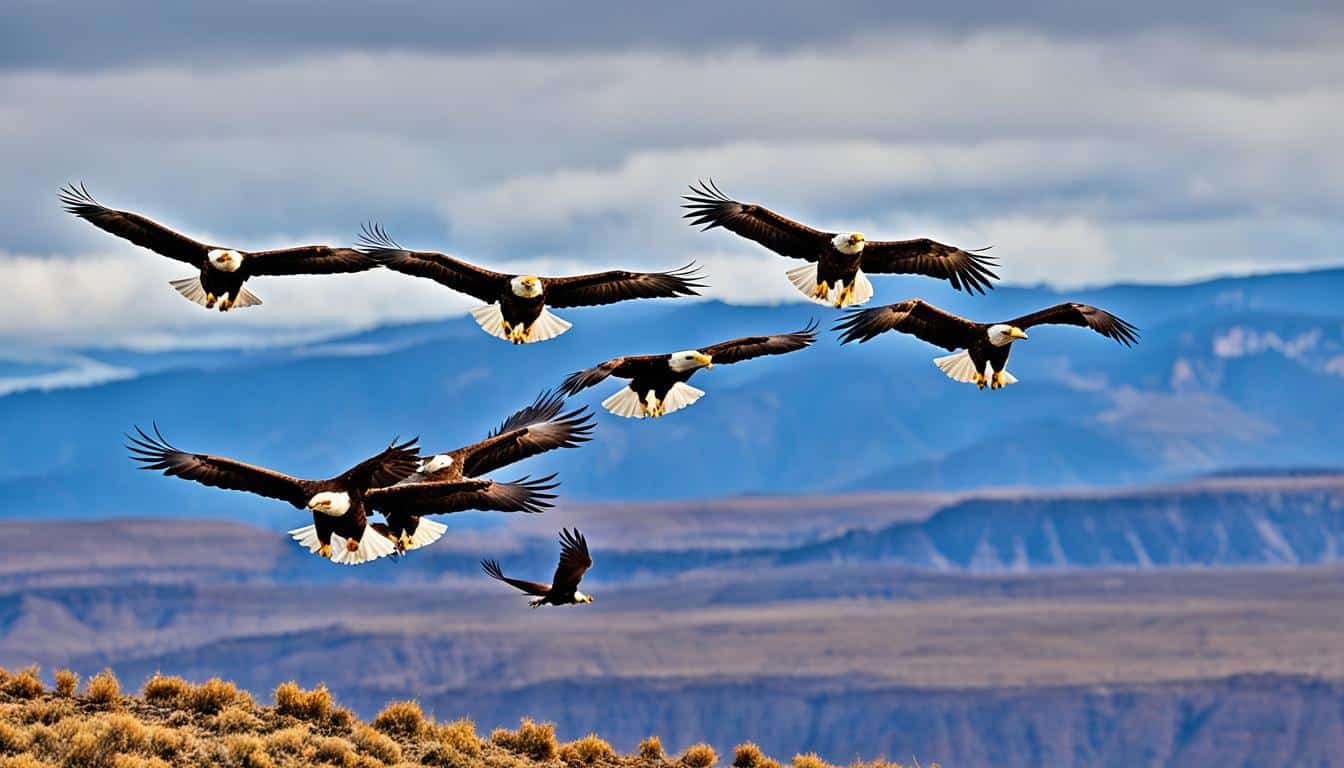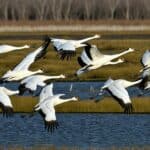Bald eagles show different migration habits due to several reasons. These include their age, where they breed, and food availability. You may see them staying in one place or flying far, looking for resources.
When the north’s water starts to freeze, adult bald eagles head south. They look for water that’s not frozen or the coast to find food. As it gets colder, you’ll spot more of them moving.
They return to where they breed from January to March. This is because the weather changes and food becomes easier to find. It’s a special time for people who love to watch and study bald eagles.
Introduction to Bald Eagle Migration
The bald eagle is famous for how it moves, searching for good places to live and eat. Its migration shows us how it adapts to survive. By watching them, we learn about their clever ways of living.
The Need for Migration
Bald eagles move because their homes change, affecting food and living space. They look for places that meet their needs but are also safe. In winter, they head to warm waters to keep finding food.
This is because the cold freezes their northern homes, making food scarce. So, they go where they can eat and live well.
Historical Patterns
Over the years, the places bald eagles fly to have shifted as the climate changes. They now head further south in winter when the north gets too cold. This is an easier journey because there is plenty of food on the way.
This shows how adaptable and tough bald eagles are. They find ways to keep living in the best places despite the challenges.
Factors Influencing Bald Eagle Migration
Bald eagles move for many reasons, leading to unique travels every year. Food availability is the main factor behind their flight. When their food sources freeze, eagles must find new places to hunt.
The age of the eagle also plays a big part in how far they migrate. Older eagles with their own territory might not travel much if they have enough to eat. But young or non-breeding eagles explore more. They look for new areas because they haven’t settled yet.
Where they live is another key factor. Eagles in the north move south when it gets cold, but eagles in warmer areas don’t have to go far. This mix of reasons shapes the eagles’ routes, showing their smart survival plans.
| Factors | Impact on Migration |
|---|---|
| Food Availability | High scarcity drives longer distances |
| Age | Juveniles are more explorative; adults are territorial |
| Geographical Location | Northern eagles migrate more than southern eagles |
Seasonal Movements of Bald Eagles
Bald eagles move with the seasons, looking for food and better living conditions. They migrate in fall and spring.
Fall Migration
In fall, they fly from the north to warmer southern lands. They do this when the fish-filled waters up north freeze over. These big birds find open water or the sea.
They leave in late autumn but the exact time changes. This journey is about finding dependable food for the winter.
Spring Migration
Once winter is over, the eagles fly back north. They do this to claim their territories and mate. This trip is quicker and more focused than their fall journey.
They show amazing skill by finding the same spots to breed each year.
What are the migration patterns of bald eagles?
Bald eagles have incredibly long migratory journeys. They can travel up to 225 miles in a day. Typically, they fly around 98 miles daily.
Wind currents and thermals are key in their flight. These help eagles fly efficiently, using less energy to cover long distances.
Migratory vs. Resident Bald Eagles
There are some big differences between migratory and resident bald eagles. This is especially true when comparing those that live in the north to those in the south. Learning about these differences gives us a peek into how they survive.
Northern vs. Southern Bald Eagles
In the colder months, northern bald eagles fly to areas with open water and lots of food. However, eagles in the south stay put all year because it’s warm and food is usually easy to find.
Food Availability
The availability of food is key for both types of eagles. When the north’s waters freeze, northern eagles have to leave to feed themselves. But eagles in the south find food easily, so they don’t need to leave their areas.
| Northern Bald Eagles | Southern Bald Eagles | |
|---|---|---|
| Migration | Frequent | Infrequent |
| Habitat Shift | Seasonal | Stable |
| Climate Adaptation | Cold-Driven | Mild Conditions |
| Food Resources | Variable, Requires Migration | Consistent, Within Territory |
Behavior of Migrating Bald Eagles
Bald eagles have unique behaviors while migrating, often during the day. Knowing these actions is key for both scientists and eagle fans.
Flight Patterns
Bald eagle flight patterns include using thermals to fly efficiently. This conserves their energy as they travel long distances. They usually fly alone but may gather in loose groups near lots of food.

Group Dynamics
Usually, migration group dynamics for bald eagles suggest they travel alone. Yet, they might join up with others for short times. They don’t form close groups, but there’s a method to how they keep a certain flying distance from one another and use the wind currents well.
| Behavioral Aspect | Description |
|---|---|
| Bald Eagle Behavior | Tend to migrate solo, utilizing thermals for soaring. |
| Flight Patterns | Rely on rising air currents; sporadically form loose groups. |
| Group Dynamics | Maintain specific distances; occasionally join in migration streams. |
Tracking Bald Eagle Migration
In the past few years, we’ve made big improvements in tracking bald eagle migration. Thanks to new telemetry technology, researchers have learned a lot about how these birds move. Now, we understand more about how bald eagles travel over big areas.
GPS devices have shown scientists the exact paths eagles take when they migrate. It turns out, bald eagles use what they see in the environment, like landmarks and natural signs, to get around. This helps them find their nests and places to eat.
This fancy new data helps us confirm what we knew and learn brand new things. Like, we’ve seen how eagles use natural signs in both places they know and new areas.
Being able to follow the birds so closely is a huge win for protecting them. We can now figure out exactly where they travel and what dangers they face. This helps us make plans to keep their important homes safe, which is key to keeping the bald eagle around.
Also, the information from tracking helps us understand how eagles deal with changes in their environments. Knowing how they adapt can help us prepare for what’s coming. This way, we can be ready to protect the eagles in the future.
The Role of Wind Currents in Migration
Bald eagles take advantage of natural wind patterns to help them migrate with less effort. Wind currents and warm air help them fly more efficiently and cover longer distances.
Using Thermals
Warm, rising air helps bald eagles soar high without much work. By flying in circles within these rising columns, they move upwards easily. This action, called thermal soaring, lets them save energy for their journey ahead.
Average Flight Speeds
When migrating, bald eagles usually fly at about 30 mph. They pick wind patterns and thermals to fly faster and use less energy. This smart flying method helps them travel many miles in one go.
| Flight Aspect | Details |
|---|---|
| Usage of Thermals | Circling within thermal updrafts to gain altitude |
| Wind Currents | Utilized for directional assistance and speed optimization |
| Average Flight Speed | Approximately 30 mph |
Case Studies of Bald Eagle Migration
Case studies on bald eagle migration are very important. They provide insights from eaglets like Destiny and Thunderbird. Researchers learn about their habits, like where they go, when, and how often they come back.
These studies use GPS technology to track their journeys. They show the eaglets’ choice of winter homes, proving coastal areas are critical. And they also prove how accurate the eagles are in finding their way back to breed, highlighting the need to protect these spots.
These research findings are key for real-world conservation work. They help focus efforts on protecting the places these birds need. By studying eagle migration closely, we can understand and meet their exact survival needs, informing better protection plans.
FAQ
What are the migration patterns of bald eagles?
Bald eagles move for many reasons such as age, where they breed, and food. Northern eagles head south when their usual waters freeze. They find open waters to fish again. These eagles usually go back to where they breed between January and March. This depends on the weather and if there’s enough food.
Why do bald eagles migrate?
They fly to find the right places to live where there’s food all the time. When lakes and rivers freeze up north, they can’t fish. So, they go where there’s open water to eat during winter.
What historical patterns are observed in bald eagle migration?
Bald eagles in the north have flown south for a long time. When the north gets too cold, they look for open waters in the south. This has been happening for generations, showing eagles can adapt to different environments.
What factors influence bald eagle migration?
What makes eagles move is if there’s enough food, how old they are, and where they live. If there’s plenty of food, grown-up eagles might not leave. But young ones and eagles that don’t breed yet often fly far away, looking for their own spot.
What does the fall migration of bald eagles look like?
In fall, they start heading south as it gets colder and waters freeze. They fly to open waters and coasts. This journey begins in late autumn. There’s enough food, so they don’t hurry to get to their winter homes.
How does the spring migration of bald eagles occur?
Spring brings eagles back to their breeding spots. They take a fast route back, eager to build their nests and start families. It’s a quicker journey compared to fall.
How do bald eagles track their migratory routes?
Today, technology helps us see where eagles go. With GPS, we know how they navigate, finding their homes and food spots using landmarks. This gives us a glimpse into their world.
How do northern bald eagles differ from southern bald eagles in migration behavior?
Northern bald eagles fly south when it gets cold to find fish. The winter is hard up north. But, southern eagles stay put, enjoying better weather and steady meals all year.
What are the typical flight patterns of migrating bald eagles?
They prefer flying in the day and use rising air to glide. This saves energy. They usually fly alone. Yet, they might form loose groups in the sky, keeping distance from each other.
How do bald eagles behave in migration group dynamics?
Eagles most often travel by themselves. Sometimes they gather in the air with others. This gathering can look scattered but organized in how they keep their space as they fly.
How important are wind currents and thermals for bald eagle migration?
Wind and warm air help eagles fly with very little effort. They can reach speeds of up to 30 mph this way. It’s a very efficient way for them to travel.
Can you provide examples of case studies in bald eagle migration?
Look at the journey of eaglets Destiny & Thunderbird. They’ve shown us a lot about how eagles travel with GPS. Studying them has taught us how to protect these birds better.







